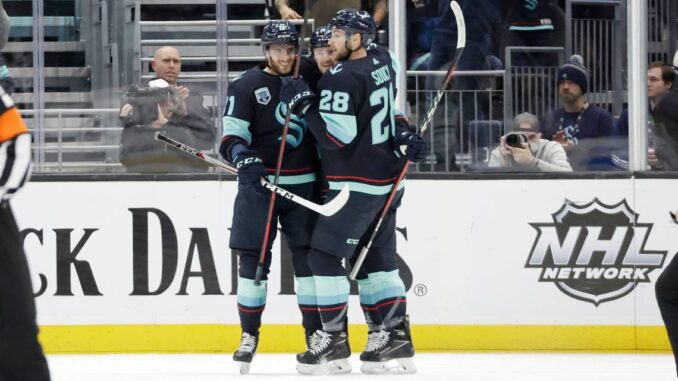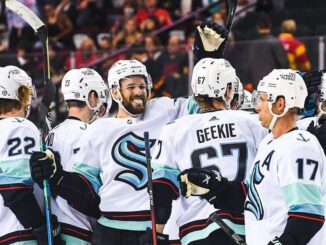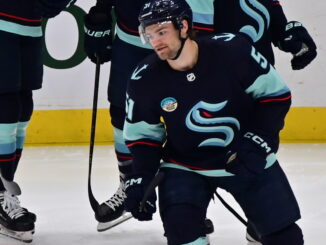
As the 2021-22 NHL regular season gradually draws to a close, we’ve accumulated enough of a sample to discover what each team is at this point of the campaign. For the newly minted Seattle Kraken, the expansion franchise has struggled in its inaugural season. After 69 games, they own a record of 22-41-6, sitting 30th out of 32 teams leaguewide. The organization’s focus has long since shifted towards making the most of the 2022 NHL Entry Draft, but the Kraken have managed to improve in a number of departments in recent weeks. Let’s dig in.
Kraken Posting Respectable Results To Finish 2021-22 Season
The Kraken’s struggles have been well-documented, but their recent performances suggest that a first-ever playoff appearance could be within reach in 2022-23. Since March 1st, the team has been 6-7-1 and looks much more competent. The following table presents Seattle’s numbers from the past month and change.
| Seattle Kraken | NHL Rank | |
| Wins | 6 | Tied-22nd |
| Points Percentage | .464 | 24th |
| Goals For/Game | 2.93 | Tied-23rd |
| Goals Against/Game | 3.29 | Tied-17th |
| PP% | 12.5% | 31st |
| PK% | 65.1% | 31st |
The most noticeable difference comes in the goals-against sector, with the Kraken hovering around league average with a mark just under 3.3 goals against per game. In the 55 games prior, Seattle conceded 3.55 goals per game, 26th in the NHL. So, what gives? Simply put, the goalies have remembered how to stop pucks, with their .888 save percentage (SV%) since the calendar turned to March, a far cry from the .877 mark, which landed them dead-last at the end of February.
Related: 3 Seattle Kraken Coaching Candidates If Hakstol Is Fired
Philipp Grubauer has yet to find his game, as his .891 SV% is ever so slightly better than his .888 mark over the rest of the season. Surprisingly, Chris Driedger has better resembled the netminder he was with the Florida Panthers, posting a .911 SV% since March 1st and winning 3 of his 6 appearances. His frailty in goal to start the year (.893 SV% before March 1st) really sunk the team as they had few steady options to turn to when Grubauer imploded to start the campaign. Apart from improved goaltending, the Kraken’s underlying metrics at 5-on-5 have seen an uptick in the most recent slate of games.
| Seattle Kraken (Since March 1st) | NHL Rank | |
| xGF/60 | 2.4 | 21st |
| xGA/60 | 2.72 | 23rd |
| xGF% | 46.9 | 23rd |
| Shots/60 | 30.3 | 16th |
| Shots Against/60 | 27.9 | 7th |
| Shot-Share % | 52.1% | 11th |
| PP xGF/60 | 7.35 | 20th |
| PK xGA/60 | 8.14 | 19th |
The Kraken’s special teams have also left a lot to be desired, ranking in the bottom four in both power-play conversion (14.7%) and penalty-kill success (74.3%). They rank well within the bottom-third in terms of expected goals – a proxy for chance quality – generated (xGF/60) and conceded (xGA/60) on special teams, but it’s their individual play that has sunk them this season. The goaltending has been abysmal, and the team’s roster isn’t exactly blessed with offensive talent.
Interestingly, the team has taken a much more aggressive approach to killing penalties. Since March 1st, the Kraken have created 2.05 xGF/60 when playing down a man, the third-highest rate in the league. They’ve also tallied four shorthanded markers, tied for first in that time. The “power kill” approach is becoming more commonplace, and it’s a strategy that goes against the grain when it comes to how teams usually kill penalties.
As shown by the table below, the Kraken’s identity all season has been one of defensive responsibility. They rank within the top 10 over the course of the year in both shots and chance quality conceded, but the goaltending has painted an unrealistic picture of their ability to prevent scoring chances. The structure is there, and a few well-placed free-agent signings could augment what is a solid, if unspectacular, foundation.
| Seattle Kraken (2021-22 Season) | NHL Rank | |
| xGF/60 | 2.1 | 29th |
| xGA/60 | 2.34 | 9th |
| xGF% | 47.4% | 23rd |
| Shots/60 | 27.7 | 28th |
| Shots Against/60 | 28.1 | 3rd |
| Shot-Share % | 49.7% | 16th |
Unsurprisingly, the team has been unable to consistently generate offense this season, posting bottom-third rates in actual goals, chance quality, and shots during 5-on-5 play. Their stout defensive play pulls them out of the gutter overall, but not by much.
Gourde & Dunn Leading The Way For The Kraken
Over the Kraken’s improved 14-game stretch, several players have led the way at both ends. Center Yanni Gourde has been a two-way force, scoring 11 points in 14 games while being tasked with shutting down the opponent’s most dangerous offensive weapons. He’s potted the most goals on the team during that span (6) and is tied for the lead in primary assists (4).
Related: Evaluating The Seattle Kraken’s 2022 Trade Deadline
On the blueline, young defenseman Vince Dunn has grabbed hold of the mantle as Seattle’s primary offensive tempo-setter from the backend. He’s tallied nine points in 14 games (4 primary assists) and has taken Mark Giordano’s role in stride since the veteran was traded to the Toronto Maple Leafs at the deadline.
Alex Wennberg (nine points in 12 games) and Daniel Sprong (three goals in six games) are among the other notable contributors, and Sprong, in particular, looks like a savvy add by general manager Ron Francis. If he’s given a longer leash than he’s been afforded thus far in his NHL career, Sprong could enjoy a breakout season in 2022-23. For a team banking on the development of young players, they should try and accrue as many lottery tickets as they can.
2022-23 Kraken Season Provides Hope
As has been well established, the Kraken stumbled in their first season as a big-league club. It’s nothing new for expansion teams, but it’s disappointing after a summer of bold free-agent signings. Still, there are positives to take from an otherwise turbulent campaign. Several young players have put forth promising performances and look set to take the next step in their development. It’s also much more challenging to foster attention to detail defensively, and the Kraken have that down pat. If things go right next season, Seattle could sneak into the postseason. After all, things can only go up from here.
Data courtesy of Evolving Hockey and the NHL. Statistics are accurate as of April 5th.




